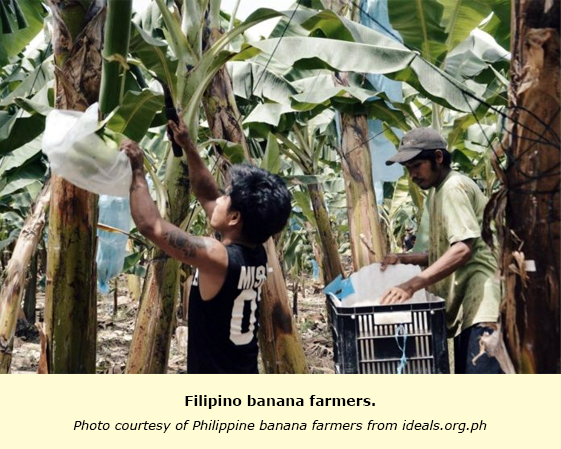Manila should expedite the forging of a free-trade agreement (FTA) with Seoul that would allow Philippine banana exports to enter South Korea at lower tariffs, and ensure that the country would not lose the East Asian market against South American competitors.

The Pilipino Banana Growers and Exporters Association (PBGEA) issued the statement after South Korea signed an FTA that allows five Central American nations to export bananas to Seoul at lower tariffs.
“The Philippines could lose South Korea as a top export destination for locally produced bananas three years from now unless tariffs are removed on this agricultural product to enable it to evenly compete with other banana exports entering this lucrative market,” the PBGEA said.
“Cheap banana imports from Central America have started to eat into the share of Philippine bananas in the Korean market and these could totally push us out of the picture by 2022 unless we get the same zero-tariff treatment as they do,” PBGEA Executive Director Stephen Antig was quoted as saying in a news statement issued on Wednesday.
Based on the estimates of the PBGEA, losing the South Korean market would result in the country foregoing close to $300 million in export revenues, with the government losing P6.5 billion in local and national tax revenues. This would affect 32,000 workers and over 200,000 dependents in the domestic banana industry of their means of livelihood, according to PBGEA.
Paul Cuyegkeng, president of Sumifru Philippines Corp., said Filipino banana growers are seeking a “level playing field” in competing with exporters from other countries not only in South Korea, but in Japan and China, as well.
“We are talking about protecting the banana industry and saving jobs,” Cuyegkeng said. “It would be highly ironic if we lose jobs in the banana industry, which is mostly based in Mindanao, when the main program of our President, who hails from this island, is job creation.”
PBGEA President Alexander N. Valoria reported that five South American nations—Costa Rica, El Salvador, Honduras, Nicaruga, and Panama—recently forged an FTA with South Korea that allow them to export bananas to the East Asian market at zero tariffs. The eradication of tariff duties on the five countries’ banana exports would be fully implemented by 2021.
Valoria added that Peru is already enjoying a tariff-free banana exports to South Korea, while Colombia and Vietnam would get the same treatment three years from now.
“Countries like Guatemala and Costa Rica currently export a small percentage of bananas to South Korea compared with the Philippines, but they could easily bump us off from this lucrative export market three years from now because our bananas would be more expensive than those coming from Central America,” he said.
Valoria explained that while Asean-Korea Free Trade Agreement (AKFTA) is favorable to Southeast Asian economies in several aspects, it is “highly disadvantageous” to the Philippines when it comes to the banana trade as the fruit was included in Korea’s Highly Sensitive List (HSL).
Inclusion in the HSL means that banana is exempted from any tariff concessions from reciprocal agreements, according to Valoria.
The only way to compete against these South American countries come 2021 is to have the tariffs on Philippine banana exports, which are currently over 30 percent, to be removed through a separate FTA, Antig said.
“The high import tariff of 30 percent on Philippine bananas is shouldered by the buyer in Korea, so even if our country is geographically nearer, a businessman planning to sell the fruit in that country would prefer to buy from Central America because of the zero tax,” he added.
“Without the actual removal of the import tariff, the Philippines will undoubtedly lose the Korean market to Central American competitors,” Antig said.
In 2017 the Philippines exported 376,659.44 metric tons (MT) of bananas to South Korea valued at $176.555 million, Philippine Statistics Authority (PSA) data showed. The volume was nearly 40 percent higher than the 269,461.431 MT exported in 2016, while the figure was 39.17 percent over than the $126.859 million export receipt.
According to PBGEA, South Korea represents a market of 30 million boxes for Philippine bananas from a production area of 8,000 hectares, or equivalent of 390,000 MT.
Valoria noted that bilateral trade between the Philippines and South Korea is “heavily lopsided” in favor of the latter. South Korean exports to the Philippines reached $8.465 billion in 2017, while Philippine exports to Korea amounted to only $4.333 billion, PSA data showed.
“With the widening agricultural trade deficit, we appreciate the call of (Socioeconomic Planning) Secretary (Ernesto) Pernia for increased government support to aid Philippine exports. But beyond doubling efforts to market the country’s export products, the government must assess the benefits and disadvantages of existing free trade agreements to reverse trade imbalances with bilateral or multilateral partners, as in the case of the AKFTA,” Antig said.
